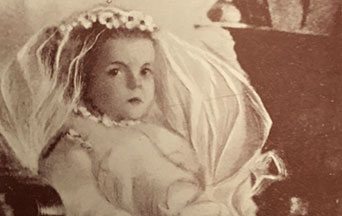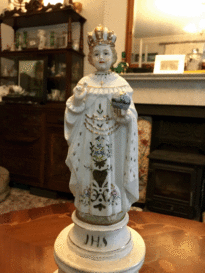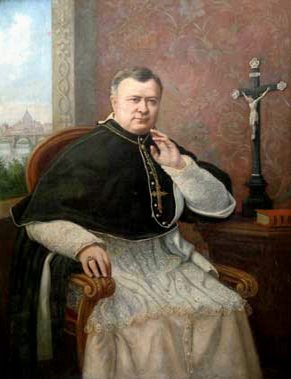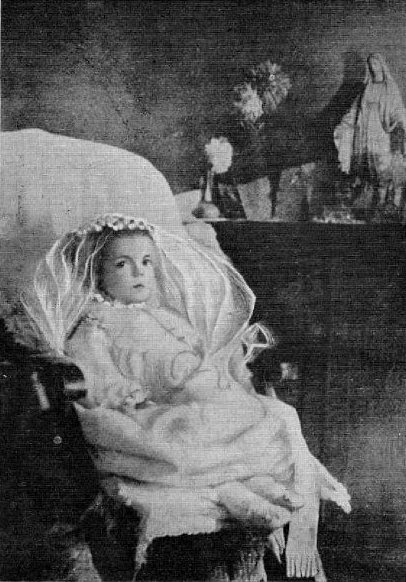 On August 4, 1903 Giuseppe Melchiorre Sarto was elevated to the Chair of Saint Peter and took the name Pius X. Twenty days later William and Mary Organ welcomed their fourth child into the world at the Royal Artillery Barracks in Ireland. They named her Ellen but she would eventually be known throughout the world simply as “Little Nellie.”
On August 4, 1903 Giuseppe Melchiorre Sarto was elevated to the Chair of Saint Peter and took the name Pius X. Twenty days later William and Mary Organ welcomed their fourth child into the world at the Royal Artillery Barracks in Ireland. They named her Ellen but she would eventually be known throughout the world simply as “Little Nellie.”
While occupying completely opposite stations in life—he the head of the universal Church, she a simple Irish girl—their lives were mysteriously linked. He waged war against the modernists of his day; she supported him with her prayers and sufferings and affectionately referred to him as “my Pope.” He prayed for a sign to change the age for reception of First Holy Communion from twelve to seven. She was that sign: at the tender age of four she craved the Eucharist and was granted special permission to receive the Bread of Angels. After her death he obtained a relic of Nellie and prayed to her.
The two were thus joined in a marvelous work to preserve baptismal innocence—so easily sullied in our impure modern world—through early reception of Holy Communion. In these days where belief in Our Lord’s True Presence is so weak and when He is so often offended with sacrilegious Communions, it is worthwhile to look back at the life of a child who so profoundly influenced the greatest Pope in the modern era.
Early Knowledge of Heavenly Things
William and Mary Aherne were married on July 4, 1896 in Waterford, Ireland. There union was founded on a deep Catholic Faith. He describes both his and Mary’s family as humble and “poor in [the] world’s wealth, but rich in those gifts of heaven, for the lack of which no boon on earth can compensate.”1
They were blessed with four children: Thomas, David, Mary, and Ellen who was born on August 24, 1903. From the tender age of two she already displayed a deep spiritual sense. While walking to Mass, hand in hand with her father, she often chattered about “Holy God”: her innocent way of referring to her Creator. William admits not knowing where she learned such things. It was largely due to the religious instruction provided by her mother Mary, who had a deep devotion to the Blessed Mother. The first words Nellie learned from her were “Jesus” and “Mary” and it was a custom of the family to pray the rosary daily. After the example of her mother, Nellie would always kiss the Crucifix and each of the large beads.
Mary Organ died of tuberculosis when Nellie was only three and half years old. This was but the first of many sufferings the child would endure during her short life. William Organ was unable to properly care for his children and with the help of a priest they were placed in separate homes. Thomas was sent to the Christian Brothers, while David was taken in by the Sisters of Mercy. Mary and Nellie were welcomed by the Good Shepherd Sisters in Cork, Ireland. This is where Ellen Organ spent the remaining eight months of her life.
Overcoming Defects
On arrival both Nellie and her sister Mary were diagnosed with whooping cough and had to be quarantined. It became evident for the nuns that this was not the only ailment that afflicted the fragile girl. Due to curvature of the spine, attributed by many to her being dropped as a baby, Nellie endured excruciating pain when either standing for a long time or just sitting still. Her health continued to deteriorate until it was discovered that she, like her mother, suffered from tuberculosis. The discomforts of her illnesses, however, did nothing to diminish her indomitable will. She possessed a choleric temperament that showed through in her dark fiery eyes and occasional impatience.2
Once, when all the children gathered in the chapel for Mass, Little Nellie was fascinated with the “singing nun” in the choir loft above and insisted on facing that direction. When told to face the altar she stamped her foot in protest. On another occasion she was unjustly accused of making the other children late for supper. They blamed Little Nellie for their tardiness. When the nun in charge rebuked her, Nellie’s immediate reaction was self-defense.

“They were free to come in whenever they wanted,” the child said, “it wasn’t my fault they were late.” She was barely four years old when this occurred so what happened next was truly remarkable. When the nun asked Nellie if she was sorry, the child immediately became docile and in spite of her innocence in the matter, fell to her knees. With folded hands she prayed, “Holy God I am very sorry for keeping the girls late for supper. Please forgive me and make me a good child.”
Infant of Prague
By this time she was assiduously absorbing the truths of the Faith taught to her by the nuns. She was most particularly enchanted with the life of Our Lord. When she learned the details of His brutal Crucifixion she burst into tears.
Displaying an innate understanding of His Omnipotence, she sorrowfully exclaimed, “Why did He allow them to do that to Him?” It was thus explained that He died because of our sins. She thus resolved to accept her own sufferings as a means of atonement and began to make great strides towards sanctity. Along the way she was assisted by rare mystical graces.
This was seen in an incident that occurred with a statue of the Infant of Prague placed upon an altar in her room. Upon learning that it represented God as a child she became enchanted and took the statue as her own. One day, she placed it on the floor in front of her and said, “Now, little Jesus, dance for me.” She then began playing her tin horn. Nurse Hall, who cared for Nellie in her last months, recalled hearing the child cry out with enthusiasm, “Look, Him dance for me.” The nurse saw nothing nor did others who entered the room. Some time later Nellie became calm once again, “He has stopped.”
The news of this event reached the ears of the Superior, Mother Mary Francis Xavier Hickey, who was naturally a bit skeptical. For some time she had hoped to construct a bake house in order to raise funds for the convent and made a deal with God. “If You really danced for Nellie,” she prayed, “send me the 300 pounds[2] we need for our bakery.” To her surprise an envelope arrived days later from an anonymous donor with the exact amount she needed to complete the project. On the cover of the envelope was written a simple message, “For the bake house.”
“I Am Now a Soldier of Holy God”
In the last days of September 1907 Nellie’s health took a turn for the worse. It was feared that she might not survive much longer so Bishop Thomas O’Callaghan agreed to administer the Sacrament of Confirmation on October 8, 1907. As everything related to religion, Little Nellie took this grace seriously and affirmed, “I am now a soldier of Holy God.” This was the turning point in her life. Mother Mary Francis affirmed that never again did she display signs of impatience.
Bishop Thomas O’Callaghan who administered the Sacrament of Confirmation on Little Nellie
Bishop O’Callaghan who administered the Sacrament of Confirmation on Little Nellie. “I am now a soldier of Holy God.”

Days of pain now turned into weeks of torture, yet through it all there was not an ounce of self-pity. On the contrary, when the pain was too much to bear Nellie would compassionately hold the Crucifix in her hands and repeat, “Poor Holy God, oh poor Holy God.” When those caring for the child showed sympathy for the patient, Nellie would respond, “What is my pain in comparison with what He suffered on the Cross for me?”
Not long afterwards Nellie, who at this stage ate very little, stopped eating all together. She complained of a sore throat which, it was later discovered, was caused by a new tooth. The discomfort children have when teething is nothing compared with this particular tooth which cut its way through at the root of her tongue. She accepted the pain of its removal—without the use of novocaine—without saying a word.
As the tuberculosis consumed her body, caries, or tooth decay, ate away her jaw.
The foul odor which exuded from the wound was so unbearable that nurses would wince when they rinsed it out with disinfectants. During this procedure Nellie patiently accepted both the pain and humiliation. She would simply hold on to the Crucifix and contemplate the sufferings of Our Savior.
Her Devotion to Our Lord in the Blessed Sacrament
Most noteworthy in the life of this child was her burning love for Our Lord in the Blessed Sacrament. In her innocence she was disturbed that Our Lord was “imprisoned.” She referred to the tabernacle as the “lock up,” the Irish term for a jail. When she first saw the Blessed Sacrament exposed in a monstrance she exclaimed, “There He is, there is Holy God.” Nurse Hall described how the child had an expression of ecstasy on her face and never took her eyes off Our Lord while she was in His Presence. From then on, as attested to by caregivers, she knew from her bed of pain when Our Lord was exposed in the monstrance for veneration in the chapel below.
As her love for Our Lord, truly present in the Eucharist, grew Little Nellie had a burning desire to receive Him into her heart. In lieu of receiving him sacramentally she opted for the next best thing. She would ask the nuns and nurses who attended Mass to come back and kiss her right after they received. She would then tell them to return to make their thanksgiving. She did likewise.
First Communion for a Child
As her tiny body continued to waste away, Mother Mary Francis consulted Father Bury on the prospect of granting Nellie permission to receive her First Communion. The Jesuit priest visited the child and asked some catechetical questions to ascertain her understanding of the Sacrament. When asked what the Eucharist is, she unhesitatingly responded, “It is Holy God. It is He who makes the nuns and everyone else holy.” She also explained with childlike candor how, “Jesus rests on the tongue, then goes into the heart.” Father Bury, convinced Nellie possessed the use of reason, heard her Confession and gave her absolution. He then sought permission from the Bishop to grant this dying child what she most ardently desired.
Approval was granted and the date was set for December 9, 1907. Upon hearing the happy news Nellie kept repeating, “Oh, I will have Holy God in my heart, I will have Holy God in my heart.” At that time the Church law required a twelve hour fast for those receiving Communion. Nellie observed this rule in spite of the fact that she was hardly eating anything. The night before her First Communion, her excitement was so great the nuns feared it would damage her already frail health. Hours before receiving however, she was able to compose herself. She became calm and reflective in preparation to finally receive the King of Kings into her heart. When anyone would try to interrupt her preparation she would ask for quiet.

During the Mass she kept her eyes riveted on the tabernacle and the movements of the priest about the altar. Upon receiving, her face was transformed with a glowing radiance. Mother Mary Francis described how, “Nellie’s features shone as if the presence of the great light in her heart reflected itself in her face. Yes, those who saw Nellie then are well convinced that the child’s appearance was not at all ordinary.”
As if to reward this child’s deep devotion, the stench emanating from her diseased jaw completely disappeared for the remainder of her life. Two days later Nellie was enrolled in the Sodality of Our Lady and thus became a Child of Mary. Her illness had advanced to such a point that they feared she might not survive. It was then decided to grant her yet another Sacrament of the Church, Anointing of the Sick.
Speaking With Holy God
Nellie went on to receive Communion thirty-two times. Her subsequent Communions only grew in fervor as the days of her brief earthly sojourn approached an end. Her preparation to receive Our Lord in the Blessed Sacrament was only outdone by the time she devoted to a proper thanksgiving: something seldom observed by modern-day Catholics. On one occasion she remained in prayer until five in the evening. On that occasion Mother Mary Francis quietly approached her bed to see if she was alright. As if awakened from a trance Nellie turned toward the Mother Superior with a glowing face and said, “Oh Mother, I am so happy. I have been talking to Holy God.” This familiar conversation was not uncommon in the last days of her life. Visitors would often enter her room and, finding her alone, would inquire if she were not lonely or afraid.
“No,” she would respond, “I was speaking with Holy God.” When asked what she spoke to Him about she responded, “I cannot say, because He told me not to tell.” As her very brief earthly sojourn was coming to an end such conversations became more frequent and she would often ask to be left alone so she might converse with Holy God.
Fame of Sanctity and Favor Granted
News of this saintly child spread like wild fire in the small town of Cork, Ireland. Request for prayers came flooding in from near and far. Sheets were eventually hung behind Nellie’s bed to attach the numerous ex-votos of thanksgiving for prayers answered. Not everyone got what they requested. This child was blessed with a discernment of God’s will, which was seen on one occasion when she was asked to pray for two nuns who were quite ill. With all naturality Nellie promised her prayers, then quickly added: “One of them will recover but the other will not.” And so it was. In spite of these prodigies Nellie remained humble and continued to develop an intense interior life.
One day she received a visit from Father Fidele, a Capuchin priest who had heard stories of this holy child. Before the visit was over Nellie asked for his blessing but the priest falling down on his knees candidly responded, “It is not I that should bless you, it is you who should bless me.” One can sense from afar the enchantment of the scene as Little Nellie dipped her finger into a holy water font and made the sign of the Cross on the pilgrim’s forehead, “May God bless you Father.”
The requests for such blessings from this child were not uncommon. The day before her death she gave her last one. At this point she was too frail to receive anyone, but a woman who was severely tormented in spirit begged to be admitted to Nellie’s room. Try as she might Mother Mary Francis was unable to deter her and thus allowed the troubled soul to enter. Barely able to speak at this point, Little Nellie garnered enough strength to make the sign of the Cross on this poor woman’s forehead. On this occasion, as if by inspiration, she changed the formula. “May God bless you,” she said, “and comfort you.” Upon leaving the room the woman declared that the moment she received this blessing, her soul completely returned to its former calm.
Final Hours
It must be noted that Nellie maintained a tender devotion to Our Lady until the end of her life. She never forgot what she learned from her mother and would reverently kiss the large beads between each decade and frequently offered the rosary for “her Pope”. One day as she was praying with Mother Mary Francis she stopped abruptly on the Fifth Sorrowful Mystery and as if by some mysterious discernment said, “Let us say this one for the Pope, for my Holy Father.” They then prayed the Litany of Our Lady after which Nellie made the sign of the Cross. Then taking the Crucifix in hand she kissed it solemnly and said, “This kiss is for my Pope, my own Holy Father.”
The last days of this victim soul were ones of excruciating pain as the tuberculosis devoured her tiny frame. Curiously enough Nellie showed no fear of her approaching death. On the contrary she told the nuns who surrounded her that she would fly to Our Lord, “on His Own day” and “I will wear my First Communion dress.”
As foretold, her agony began on the morning of “God’s day”, Sunday, February 2, 1908, the Feast of the Purification of Our Lady. She was clothed in her First Communion dress. At three in the afternoon she became very calm and looked intently at “something” at the foot of her bed. She made an attempt to raise herself in that direction but was too weak. However, her gaze did not leave that spot. The look on her face was not the glazed expression of someone dying. Her eyes were filled with tears of joy as she appeared to be speaking to someone. Slowly her eyes moved upward, as if following that “something” over her bed. Moments later, with a smile of perfect satisfaction, she breathed her last. She was only four years, five months and eight days old.
Body Found to Be Totally Incorrupt
Nellie was initially buried in the town cemetery but the nuns who had cared for her lamented the loss of such a predilect child and requested her reburial in the convent cemetery. To the astonishment of those present at her exhumation a year later, Nellie’s body was not only found to be totally incorrupt, but her clothes were in exactly the same condition as the day she was originally buried. Even the holy medal which hung around her neck was still shining.
After her death, Pope Saint Pius X learned of Nellie’s extraordinary life from his Secretary of State, Cardinal Merry del Val. The holy Pontiff immediately recognized it as a sign he had prayed for, to know if it was the case to allow children of seven to receive their First Communion. He immediately requested a lock of hair which was provided by Nellie’s sister Mary. Part of the relic was given to Cardinal Merry del Val.
The story of Little Nellie quickly spread. Biographies appeared in various languages including Japanese and Dutch. The most noteworthy however was that of Frenchman, Fr. Bernard des Ronces. This account of Little Nellie’s life was presented to the Pope. The saintly Pontiff was enchanted with the gift but upon hearing her name his features lit up with a kindly smile.
“She was a little angel,” he affirmed. “Her patience was admirable, her resignation in suffering perfect. Moreover, she showed a superior intelligence in supernatural matters. As for her innocence, it is beyond doubt…she was an angel, living with angels.” As he leafed through the book he remarked, “From a little life you have made a big book.” Then as he came to a picture of Nellie he exclaimed, “Ah, there she is,” and gazed at it admiringly.

The Pope went on to write his marvelous encyclical Quam Singulari. He argued that to deny children the “embrace of Christ” was thus depriving them of “the food of their interior life,” which placed their first innocence in danger. This change in Church practice might have never occurred if not for an extraordinary little girl named Ellen Organ. If she is ever raised to the altars, she will be the youngest canonized saint not martyred.
In spite of living such a short life Little Nellie left an indelible mark on the world. Like a shooting star, this marvelous soul appeared on the horizon. She lit up the sky of a turbulent twentieth century with her ardent devotion to Our Lord in the Blessed Sacrament and tender devotion to Our Lady. Finally after being granted the grace to receive the Bread of Angels this luminous soul disappeared over the horizon. Perhaps the most important thing that history will remember of the great Ellen Organ is that she was a sign for the greatest Pope in the modern era. A sign which paved the way for the “little ones”, as Our Lord so affectionately referred to them, to “come to Him. For such is the kingdom of heaven.”

